Myanmar: High holiday count among productivity worries this year
Low private-sector productivity is one of the factors that could challenge growth in Myanmar and the number of public holidays in the country this year is among the top productivity killers, manufacturers said.
Myanmar will have a total of 27 public holidays in 2020, which is nearly a month, excluding Saturdays and Sundays. By comparison, Thailand has 23, Malaysia 14, and Singapore 11.
The fewer number of working days decreases manufacturing activity, which is bad for business, Daw Khine Khine Nwe, associate secretary of the Union of Myanmar Federation of Chambers of Commerce and Industry and secretary of the Myanmar Garment Manufacturers Association, told The Myanmar Times.
She added that if the public holidays coincide with the weekend, there will be even longer stretches of time-off. “This significantly affects productivity. Adding more holidays in a time of low productivity is just an even more negative impact,” she said.
In a report released on January 15, Gevorg Sargsyan, acting World Bank country director for Myanmar, stated, “Myanmar continues to experience robust growth but as the global economic environment deteriorates, the importance of domestic factors such as prevalent conflict, low private sector productivity, and institutional constraints challenge investor sentiment and hamper the country’s long-term prospects.”
During the interview, Daw Khine Khine Nwe discussed at length the challenges low productivity poses to the manufacturing sector and how they can be overcome:
How do more holidays affect the garment industry in particular?
Although the number of days off for the Thingyan holiday has been reduced from 10 to five, most garment factories still let the workers have 10 days off because of difficulties in transportation. Also, workers from rural areas want to return home when there are long holidays. But when they have too many holidays, they need more time to readjust to work.
Whether the products are distributed locally or exported to other countries, holidays really delay the manufacturing and distribution process. We can rush the manufacturing, but have to compensate for bad quality. We also have to pay double for overtime, which increases the production costs.
According to the Leave and Holidays Act, 1951 which was amended in 2014, at least one day of the week must be set as a paid day-off, which is around 52 days off a year, excluding public holidays.
I’m worried about the number of holidays in 2020. There’s no production during holidays.
We have to pay double for those who work on holidays on top of the usual production costs. These are real issues for businesses. We’re not putting the blame on anyone, but the authorities need to know that we have such problems and help address them.
Skills and technology are necessary to raise productivity. Both employers and employees should have long-term vision because the economy will only develop when businesses thrive. For these reasons, the government needs to consider reducing the number of unproductive days, and helping to increase productivity through policy.
The productivity of a worker isn’t improved in a day, a month or a year, they will have to increase their productivity continuously.
How important is productivity for the country’s economic growth?
Productivity is directly proportionate to a country’s economic growth so if productivity is high, so is a country’s standard of living.
Labour productivity is a main driver for Myanmar’s economy. Because labour productivity is a factor in production as well as in services, there are many impacts on the country’s economy.
When investments enter the country, jobs are created. If employment increases productivity will increase, and if production increases the country’s economy will grow.
Myanmar has been granted the EU’s Generalised Scheme of Preferences, so foreign investors are interested in sectors that enjoy GSP and they invest more in those sectors. Compared with neighbouring countries, Myanmar also has a larger working age population so it is an attraction for foreign investors.
Why is productivity so low? What is happening in workplaces?
First of all, our country is transitioning to democracy right now. Due to the education system in the past, workers who completed basic education are limited. The effects of this are still being felt to this day.
Myanmar’s economy is now growing again in every sector and everyone is trying to integrate with regional and global markets. Compared with the past, businesses are transitioning as well, but much of the labour force lacks basic education or professional expertise, leading to low productivity.
It is not easy to collect data and statistics in Myanmar for reference but in a survey for ASEAN, Myanmar’s labour productivity per hour was only US$5 in 2018, while Thailand’s is US$15.
Right now, it is important to have indices to measure the country’s productivity as most countries are setting minimum wages according to productivity.
I have heard that the and Ministry of Planning, Finance and Industry intends to release a Producers Price Index for Myanmar with the help of the World Bank. It is best if this comes out as soon as possible. – Translated
Source: https://www.mmtimes.com/news/high-holiday-count-among-productivity-worries-year.html


 Thailand
Thailand




